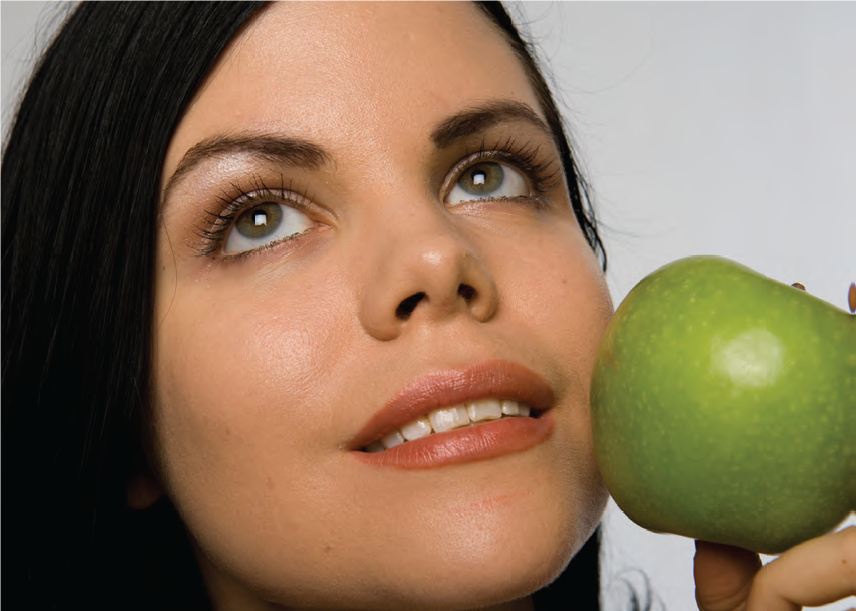While the skincare industry touts its latest, greatest miracle-working scientific formulations, actual science increasingly links healthy skin to what you put IN your body, not ON it.
Skin is the largest organ of the body. It’s the only one that is instantly visible. And it is vulnerable to all sorts of attacks, including dryness, excess oil, wrinkles, sunburn, acne, dermatitis, rosacea, eczema, psoriasis, seborrhea, and various forms of cancer. Millions of consumers shell out billions of dollars on topical skincare products each year in an effort to improve the look and feel of their skin. All the while, they may be missing a more obvious, cheaper, and better way to reach their goal. Food.
In their book Beauty Basics for Teens, Dianne York-Goldman and Mitchel P. Goldman, M.D., urge a balanced diet that includes carbohydrates, protein, nutrients and fiber, but is low in saturated fats and empty calories. They also advise drinking at least eight 8-ounce glasses of water each day for proper hydration. The goal is to eat foods rich in vitamins, minerals, antioxidants, and healthy fats. Melody L. Meyer of Albert’s Organics, a California-based natural products distributor, suggests leafy green vegetables for iron and calcium, sweet juicy fruits (especially at breakfast), a variety of whole grains, and easy-to-digest proteins like legume soups, paneer (cheese made from boiling milk, adding lemon and straining solids), and lassi (diluted yogurt and spice drinks).
Carotenoids, which are found in red and orange fruits as well as in yellow and dark green vegetables, are recommended by Sharrann Simmons of Cognis Nutrition & Health, an Illinois-based food technology company. She says that carotenoid lutein has been shown to protect skin against UV-damage, improve skin hydration, encourage elasticity and enhance beneficial lipid levels. For its “Beauty from Within” campaign, DSM Functional Food Marketing of New Jersey also enlists carotenoids, as well as antioxidant vitamins C and E, green tea extracts, omega-3 fatty acids (which can be found in fish and flaxseed), and polyphenols (derived from olives). Consumers seem to be getting the message. A recent study by the Mintel Group, a market research fi rm, notes that 2008 saw the debut of more than twice as many new beauty foods and beverage products as there were in 2007.
Dermatologist and author Nicholas Perricone urges a diet loaded with these essential proteins: fish, poultry and, occasionally, lean beef, pork or ham. He also suggests consumption of soy foods like tofu and tempeh, egg whites, low-fat cottage cheese, low-fat milk, and yogurt. For carbs, he favors squash, spinach, onions, green beans, asparagus, cabbage, cauliflower, eggplant, collard greens, escarole, green peppers, strawberries, raspberries, apples, blackberries, blueberries, cantaloupe, honeydew, and kiwi. Recommended fats include oils derived from olives, walnuts, safflower, soybeans, rapeseed (canola), and sunflowers, as well as nut butters and avocado.
Perricone also is high on the following ten “Superfoods”: Aτai (pronounced ah-sigh-ee), a high-energy berry that grows in the Amazon The allium family of foods, including garlic, onions, leeks, scallions, shallots, and chives, all of which are rich in flavonoids. Barley, which is not only low on the Glycemic Index, but high in both soluble and insoluble fiber. Green foods, which are derived from cereal grasses and blue-green algae. Buckwheat, also low on the glycemic scale, and which may be substituted for less healthful grains like rice, wheat, and corn. Beans and lentils, an alternative to fattier meat proteins. Hot peppers, which are high in heart-healthy, anti-inflammatory compounds. Nuts and seeds, which are a source of good fats. Sprouts for their enzyme content.
Yogurt and kefir, fermented dairy products that add digestion-aiding probiotics to the diet. J.T. Ryan is a licensed physical therapist and owner of Healing Touch in Howell. The company makes and markets handmade natural body-care products. She emphasizes the need for trace minerals and electrolytes, which she calls “a key to cellular regeneration.” For example, Ryan says, a deficiency in copper will lead to scar formation during the skin’s 40-day cycle period. Foods rich in copper include most nuts (especially Brazils and cashews), seeds (especially poppy and sunflower), chickpeas, liver and oysters. Are there foods that should be shunned if your goal is shiny, smooth skin? Most definitely. This is particularly true if you are worried about acne. Naturopath Alan C. Logan, who teamed with dermatologist Valori Treloar on the 2007 book The Clear Skin Diet, cautions against the foods most popular with American teenagers—pizza, hamburgers, cookies, crackers, fried potatoes, salty snacks and sweetened beverages.
Even milk consumption is “strongly associated with acne,” the authors claim. In place of these no-no’s, Logan argues for a diet that focuses on the omega-3 fatty acid eicosapentaenoic acid (EPA), found in fish like mackerel, sardines and salmon, tomato extract with the carotenoid lycopene, marine fish that are rich in collagen, and a high-flavanol cocoa extract. Logan explains that inflammation is at the core of acne, and that oxidative stress, a byproduct of the standard American diet, “fans the flames of inflammation.” Fish oil, he says, especially EPA, blocks the production of the inflammatory chemicals. This also is why antioxidant fruits and vegetables are so important. Does this mean you have to toss away all your lotions, creams and ointments? Of course not. They definitely serve a purpose. But keep in mind that if you really want a smooth, healthy complexion, a good nutritional foundation is where you should start.
Editor’s Note: New Jersey-based freelance writer Alan Richman is the former editor of Whole Foods Magazine.





